Detailed Business Strategy Report: Aldi's Strategic Planning Framework
VerifiedAdded on 2020/10/05
|18
|5686
|253
Report
AI Summary
This report provides a comprehensive analysis of Aldi's business strategy, encompassing its mission, vision, objectives, and goals, and how these elements inform strategic planning. It delves into the factors Aldi considers when formulating its strategic plans, the usefulness of techniques like BCG matrix and PIMS, and the importance of organizational and environmental audits. The report also examines stakeholder analysis, proposes a new strategy for Aldi, and assesses market appropriateness and justification for market entry strategies. Furthermore, it outlines the roles and responsibilities of personnel involved in strategy implementation, analyzes resource requirements, and explores the use of SMART targets in achieving strategic objectives. Overall, the report provides a detailed overview of Aldi's strategic framework and its application in the competitive market.
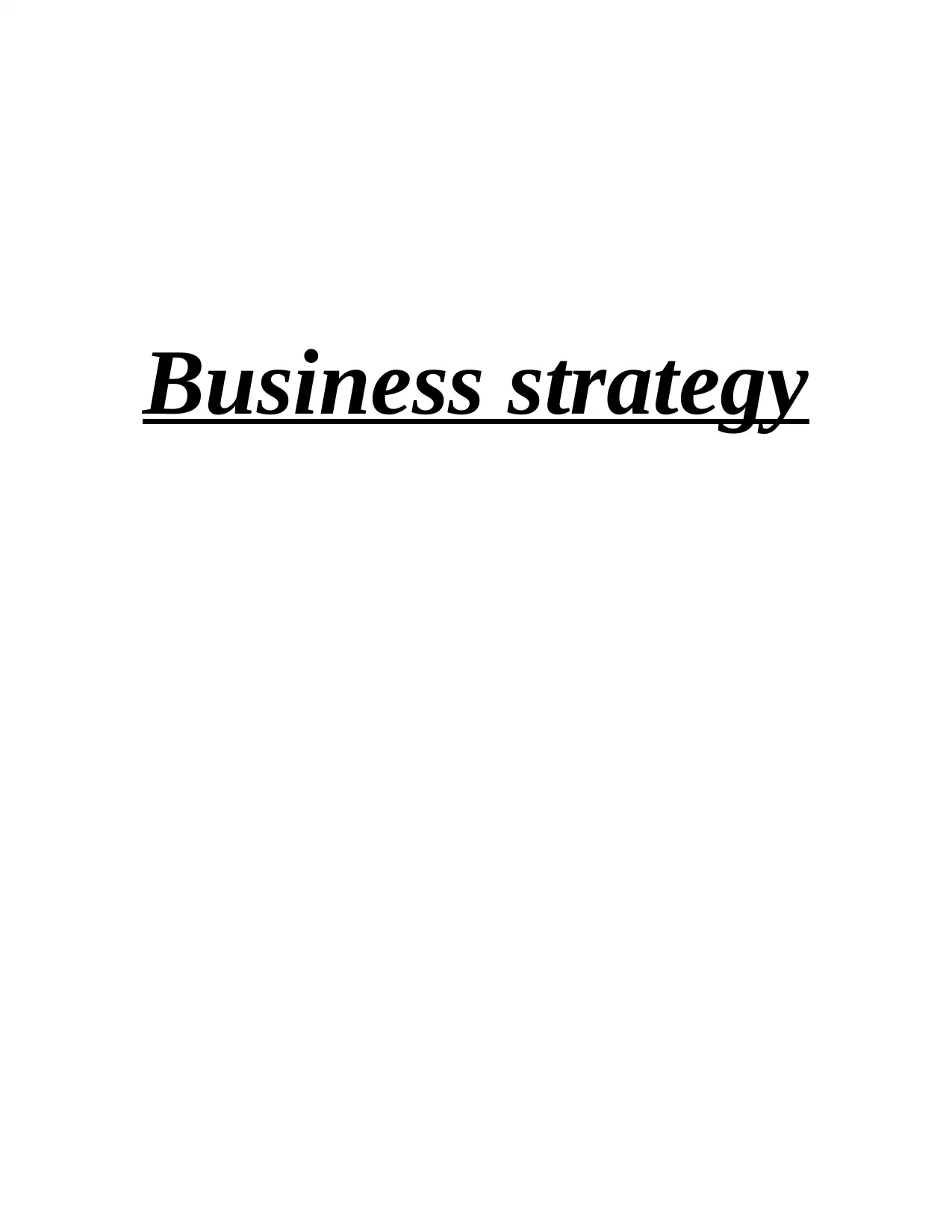
Business strategy
Paraphrase This Document
Need a fresh take? Get an instant paraphrase of this document with our AI Paraphraser
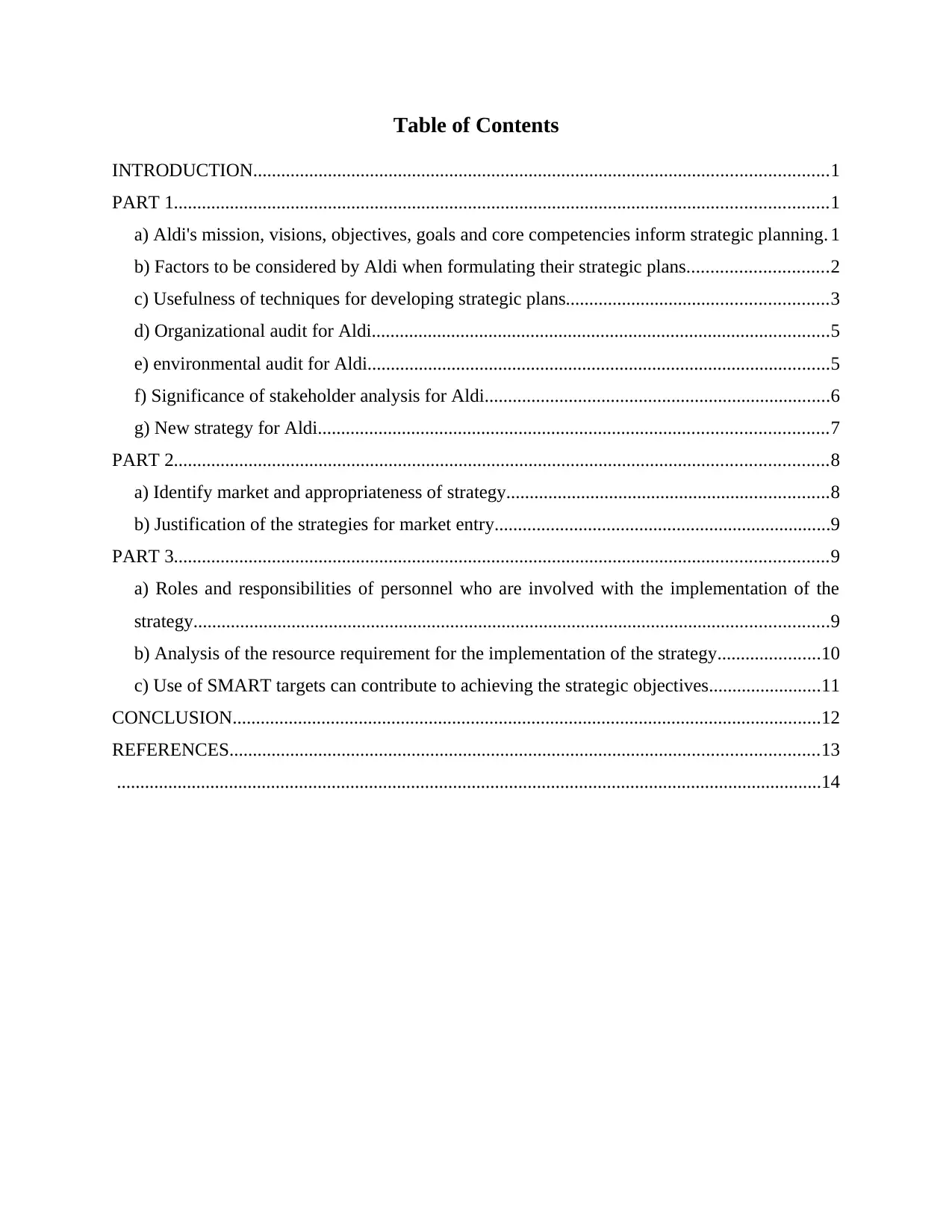
Table of Contents
INTRODUCTION...........................................................................................................................1
PART 1............................................................................................................................................1
a) Aldi's mission, visions, objectives, goals and core competencies inform strategic planning. 1
b) Factors to be considered by Aldi when formulating their strategic plans..............................2
c) Usefulness of techniques for developing strategic plans........................................................3
d) Organizational audit for Aldi..................................................................................................5
e) environmental audit for Aldi...................................................................................................5
f) Significance of stakeholder analysis for Aldi..........................................................................6
g) New strategy for Aldi.............................................................................................................7
PART 2............................................................................................................................................8
a) Identify market and appropriateness of strategy.....................................................................8
b) Justification of the strategies for market entry........................................................................9
PART 3............................................................................................................................................9
a) Roles and responsibilities of personnel who are involved with the implementation of the
strategy........................................................................................................................................9
b) Analysis of the resource requirement for the implementation of the strategy......................10
c) Use of SMART targets can contribute to achieving the strategic objectives........................11
CONCLUSION..............................................................................................................................12
REFERENCES..............................................................................................................................13
.......................................................................................................................................................14
INTRODUCTION...........................................................................................................................1
PART 1............................................................................................................................................1
a) Aldi's mission, visions, objectives, goals and core competencies inform strategic planning. 1
b) Factors to be considered by Aldi when formulating their strategic plans..............................2
c) Usefulness of techniques for developing strategic plans........................................................3
d) Organizational audit for Aldi..................................................................................................5
e) environmental audit for Aldi...................................................................................................5
f) Significance of stakeholder analysis for Aldi..........................................................................6
g) New strategy for Aldi.............................................................................................................7
PART 2............................................................................................................................................8
a) Identify market and appropriateness of strategy.....................................................................8
b) Justification of the strategies for market entry........................................................................9
PART 3............................................................................................................................................9
a) Roles and responsibilities of personnel who are involved with the implementation of the
strategy........................................................................................................................................9
b) Analysis of the resource requirement for the implementation of the strategy......................10
c) Use of SMART targets can contribute to achieving the strategic objectives........................11
CONCLUSION..............................................................................................................................12
REFERENCES..............................................................................................................................13
.......................................................................................................................................................14

⊘ This is a preview!⊘
Do you want full access?
Subscribe today to unlock all pages.

Trusted by 1+ million students worldwide

INTRODUCTION
Business strategy is refers to the course of action which help business organization to
attain particular goals and objectives in appropriate time frame. Thus, it is important for
company develop an effective strategy in order to accomplish long term targets (Business
Strategy, 2015). As it also includes organizational mission, vision, objectives and business plan
that directly contribute in enhancing the positive brand image of the company at market place.
With the assistance of strategic evaluation company can easily evaluate their strength in order to
capture future opportunities. Along with this, it also help business organization to attain
competitive advantage by satisfying customers needs and wants. Present report is based on Aldi,
is the leading brand of discount supermarket chain which deals in household goods, food and
beverage. It serve their services in over the world. Report discussed about Aldi vision, mission
and objectives that implement at the time of making strategic planning. Organisational and
environmental audit of Aldi is also mentioned in this report. Along with this, significance of
stakeholder analysis is also cover in this project. At last, use of SMART target is discussed that
help in attaining strategic objectives in appropriate way.
PART 1
a) Aldi's mission, visions, objectives, goals and core competencies inform strategic planning
Strategic planning consider as an management planning that help in setting priorities,
focus on energy and resources with the aim of accomplishing long term goals and objectives.
Mainly, it define the strategy or direction that support manager of the company to making
appropriate decisions. Along with this, it also includes employees roles and responsibilities
which may assist in attaining its common goals within the appropriate time frame. Thus, it is
important duty of Aldi manager to formulate an appropriate strategies so that they can easily
increase the chances of attaining positive outcomes. For attaining the same, manager also
responsible for including factors such as environmental audit, stakeholders, organization audit
and more while formulating strategies (Klettner, Clarke and Boersma, 2014). By this company
can easily attain various opportunities and achieve better success at market place. In this context,
mission, vision, goals and objectives is also implement while formulating the strategies within
the company. All these can be understood by following points:
1
Business strategy is refers to the course of action which help business organization to
attain particular goals and objectives in appropriate time frame. Thus, it is important for
company develop an effective strategy in order to accomplish long term targets (Business
Strategy, 2015). As it also includes organizational mission, vision, objectives and business plan
that directly contribute in enhancing the positive brand image of the company at market place.
With the assistance of strategic evaluation company can easily evaluate their strength in order to
capture future opportunities. Along with this, it also help business organization to attain
competitive advantage by satisfying customers needs and wants. Present report is based on Aldi,
is the leading brand of discount supermarket chain which deals in household goods, food and
beverage. It serve their services in over the world. Report discussed about Aldi vision, mission
and objectives that implement at the time of making strategic planning. Organisational and
environmental audit of Aldi is also mentioned in this report. Along with this, significance of
stakeholder analysis is also cover in this project. At last, use of SMART target is discussed that
help in attaining strategic objectives in appropriate way.
PART 1
a) Aldi's mission, visions, objectives, goals and core competencies inform strategic planning
Strategic planning consider as an management planning that help in setting priorities,
focus on energy and resources with the aim of accomplishing long term goals and objectives.
Mainly, it define the strategy or direction that support manager of the company to making
appropriate decisions. Along with this, it also includes employees roles and responsibilities
which may assist in attaining its common goals within the appropriate time frame. Thus, it is
important duty of Aldi manager to formulate an appropriate strategies so that they can easily
increase the chances of attaining positive outcomes. For attaining the same, manager also
responsible for including factors such as environmental audit, stakeholders, organization audit
and more while formulating strategies (Klettner, Clarke and Boersma, 2014). By this company
can easily attain various opportunities and achieve better success at market place. In this context,
mission, vision, goals and objectives is also implement while formulating the strategies within
the company. All these can be understood by following points:
1
Paraphrase This Document
Need a fresh take? Get an instant paraphrase of this document with our AI Paraphraser
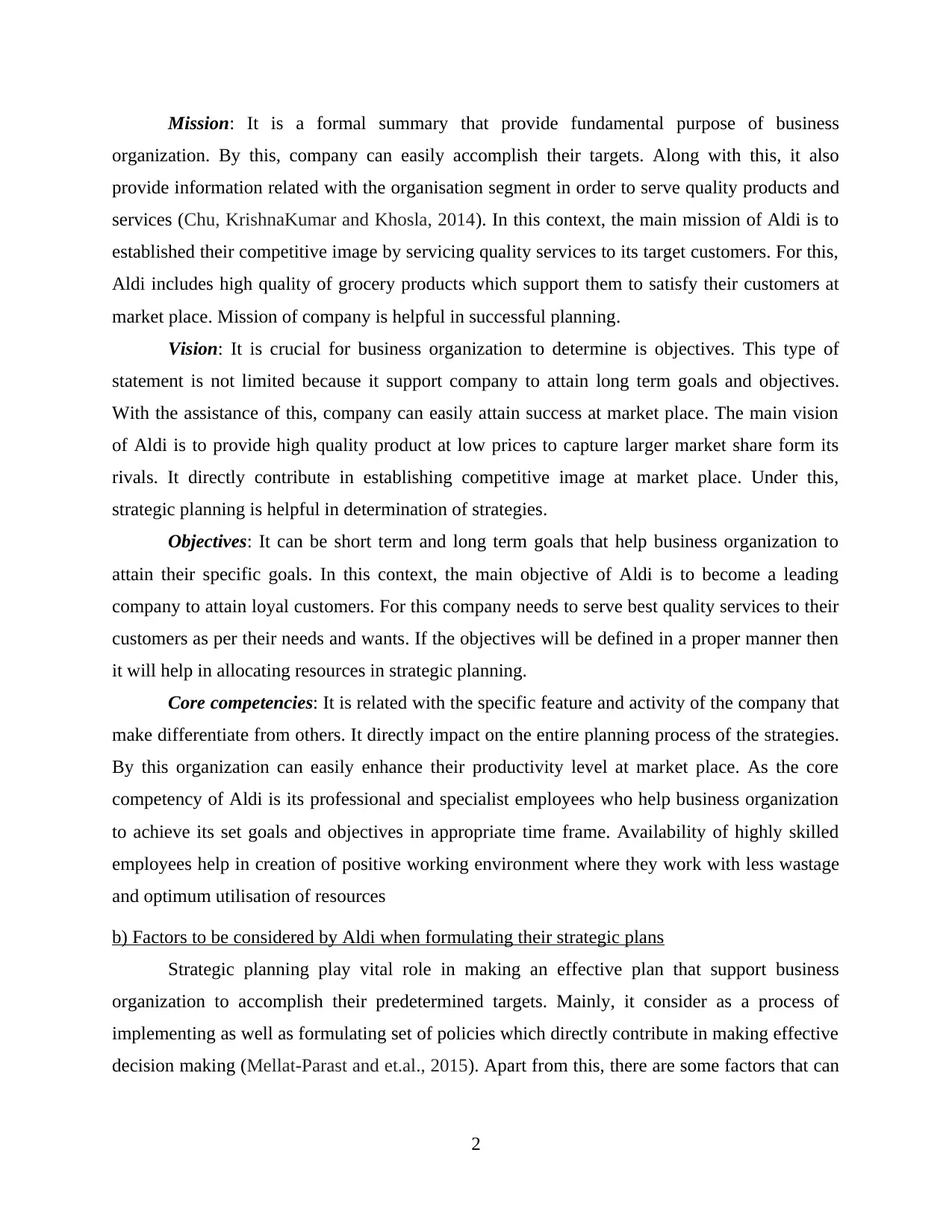
Mission: It is a formal summary that provide fundamental purpose of business
organization. By this, company can easily accomplish their targets. Along with this, it also
provide information related with the organisation segment in order to serve quality products and
services (Chu, KrishnaKumar and Khosla, 2014). In this context, the main mission of Aldi is to
established their competitive image by servicing quality services to its target customers. For this,
Aldi includes high quality of grocery products which support them to satisfy their customers at
market place. Mission of company is helpful in successful planning.
Vision: It is crucial for business organization to determine is objectives. This type of
statement is not limited because it support company to attain long term goals and objectives.
With the assistance of this, company can easily attain success at market place. The main vision
of Aldi is to provide high quality product at low prices to capture larger market share form its
rivals. It directly contribute in establishing competitive image at market place. Under this,
strategic planning is helpful in determination of strategies.
Objectives: It can be short term and long term goals that help business organization to
attain their specific goals. In this context, the main objective of Aldi is to become a leading
company to attain loyal customers. For this company needs to serve best quality services to their
customers as per their needs and wants. If the objectives will be defined in a proper manner then
it will help in allocating resources in strategic planning.
Core competencies: It is related with the specific feature and activity of the company that
make differentiate from others. It directly impact on the entire planning process of the strategies.
By this organization can easily enhance their productivity level at market place. As the core
competency of Aldi is its professional and specialist employees who help business organization
to achieve its set goals and objectives in appropriate time frame. Availability of highly skilled
employees help in creation of positive working environment where they work with less wastage
and optimum utilisation of resources
b) Factors to be considered by Aldi when formulating their strategic plans
Strategic planning play vital role in making an effective plan that support business
organization to accomplish their predetermined targets. Mainly, it consider as a process of
implementing as well as formulating set of policies which directly contribute in making effective
decision making (Mellat-Parast and et.al., 2015). Apart from this, there are some factors that can
2
organization. By this, company can easily accomplish their targets. Along with this, it also
provide information related with the organisation segment in order to serve quality products and
services (Chu, KrishnaKumar and Khosla, 2014). In this context, the main mission of Aldi is to
established their competitive image by servicing quality services to its target customers. For this,
Aldi includes high quality of grocery products which support them to satisfy their customers at
market place. Mission of company is helpful in successful planning.
Vision: It is crucial for business organization to determine is objectives. This type of
statement is not limited because it support company to attain long term goals and objectives.
With the assistance of this, company can easily attain success at market place. The main vision
of Aldi is to provide high quality product at low prices to capture larger market share form its
rivals. It directly contribute in establishing competitive image at market place. Under this,
strategic planning is helpful in determination of strategies.
Objectives: It can be short term and long term goals that help business organization to
attain their specific goals. In this context, the main objective of Aldi is to become a leading
company to attain loyal customers. For this company needs to serve best quality services to their
customers as per their needs and wants. If the objectives will be defined in a proper manner then
it will help in allocating resources in strategic planning.
Core competencies: It is related with the specific feature and activity of the company that
make differentiate from others. It directly impact on the entire planning process of the strategies.
By this organization can easily enhance their productivity level at market place. As the core
competency of Aldi is its professional and specialist employees who help business organization
to achieve its set goals and objectives in appropriate time frame. Availability of highly skilled
employees help in creation of positive working environment where they work with less wastage
and optimum utilisation of resources
b) Factors to be considered by Aldi when formulating their strategic plans
Strategic planning play vital role in making an effective plan that support business
organization to accomplish their predetermined targets. Mainly, it consider as a process of
implementing as well as formulating set of policies which directly contribute in making effective
decision making (Mellat-Parast and et.al., 2015). Apart from this, there are some factors that can
2
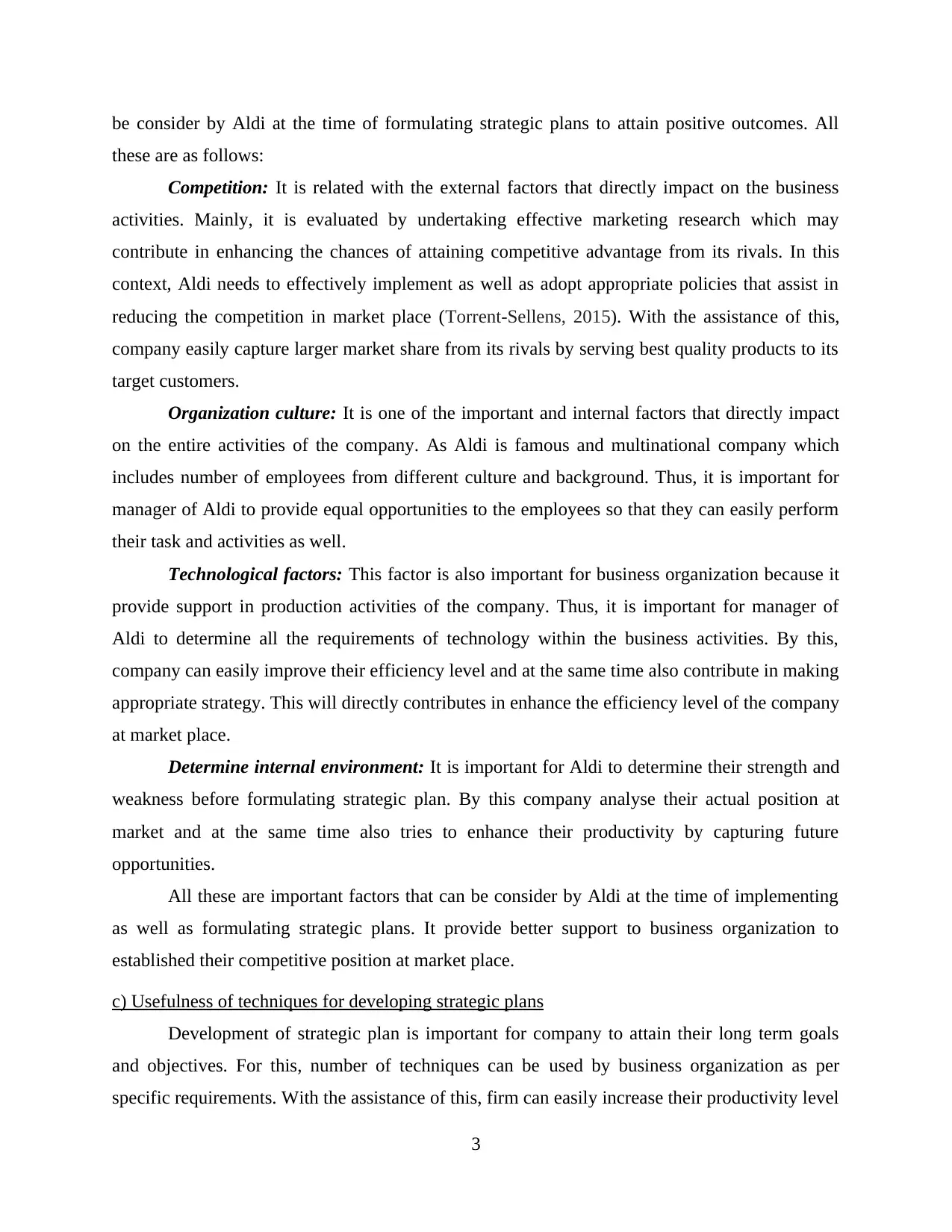
be consider by Aldi at the time of formulating strategic plans to attain positive outcomes. All
these are as follows:
Competition: It is related with the external factors that directly impact on the business
activities. Mainly, it is evaluated by undertaking effective marketing research which may
contribute in enhancing the chances of attaining competitive advantage from its rivals. In this
context, Aldi needs to effectively implement as well as adopt appropriate policies that assist in
reducing the competition in market place (Torrent-Sellens, 2015). With the assistance of this,
company easily capture larger market share from its rivals by serving best quality products to its
target customers.
Organization culture: It is one of the important and internal factors that directly impact
on the entire activities of the company. As Aldi is famous and multinational company which
includes number of employees from different culture and background. Thus, it is important for
manager of Aldi to provide equal opportunities to the employees so that they can easily perform
their task and activities as well.
Technological factors: This factor is also important for business organization because it
provide support in production activities of the company. Thus, it is important for manager of
Aldi to determine all the requirements of technology within the business activities. By this,
company can easily improve their efficiency level and at the same time also contribute in making
appropriate strategy. This will directly contributes in enhance the efficiency level of the company
at market place.
Determine internal environment: It is important for Aldi to determine their strength and
weakness before formulating strategic plan. By this company analyse their actual position at
market and at the same time also tries to enhance their productivity by capturing future
opportunities.
All these are important factors that can be consider by Aldi at the time of implementing
as well as formulating strategic plans. It provide better support to business organization to
established their competitive position at market place.
c) Usefulness of techniques for developing strategic plans
Development of strategic plan is important for company to attain their long term goals
and objectives. For this, number of techniques can be used by business organization as per
specific requirements. With the assistance of this, firm can easily increase their productivity level
3
these are as follows:
Competition: It is related with the external factors that directly impact on the business
activities. Mainly, it is evaluated by undertaking effective marketing research which may
contribute in enhancing the chances of attaining competitive advantage from its rivals. In this
context, Aldi needs to effectively implement as well as adopt appropriate policies that assist in
reducing the competition in market place (Torrent-Sellens, 2015). With the assistance of this,
company easily capture larger market share from its rivals by serving best quality products to its
target customers.
Organization culture: It is one of the important and internal factors that directly impact
on the entire activities of the company. As Aldi is famous and multinational company which
includes number of employees from different culture and background. Thus, it is important for
manager of Aldi to provide equal opportunities to the employees so that they can easily perform
their task and activities as well.
Technological factors: This factor is also important for business organization because it
provide support in production activities of the company. Thus, it is important for manager of
Aldi to determine all the requirements of technology within the business activities. By this,
company can easily improve their efficiency level and at the same time also contribute in making
appropriate strategy. This will directly contributes in enhance the efficiency level of the company
at market place.
Determine internal environment: It is important for Aldi to determine their strength and
weakness before formulating strategic plan. By this company analyse their actual position at
market and at the same time also tries to enhance their productivity by capturing future
opportunities.
All these are important factors that can be consider by Aldi at the time of implementing
as well as formulating strategic plans. It provide better support to business organization to
established their competitive position at market place.
c) Usefulness of techniques for developing strategic plans
Development of strategic plan is important for company to attain their long term goals
and objectives. For this, number of techniques can be used by business organization as per
specific requirements. With the assistance of this, firm can easily increase their productivity level
3
⊘ This is a preview!⊘
Do you want full access?
Subscribe today to unlock all pages.

Trusted by 1+ million students worldwide
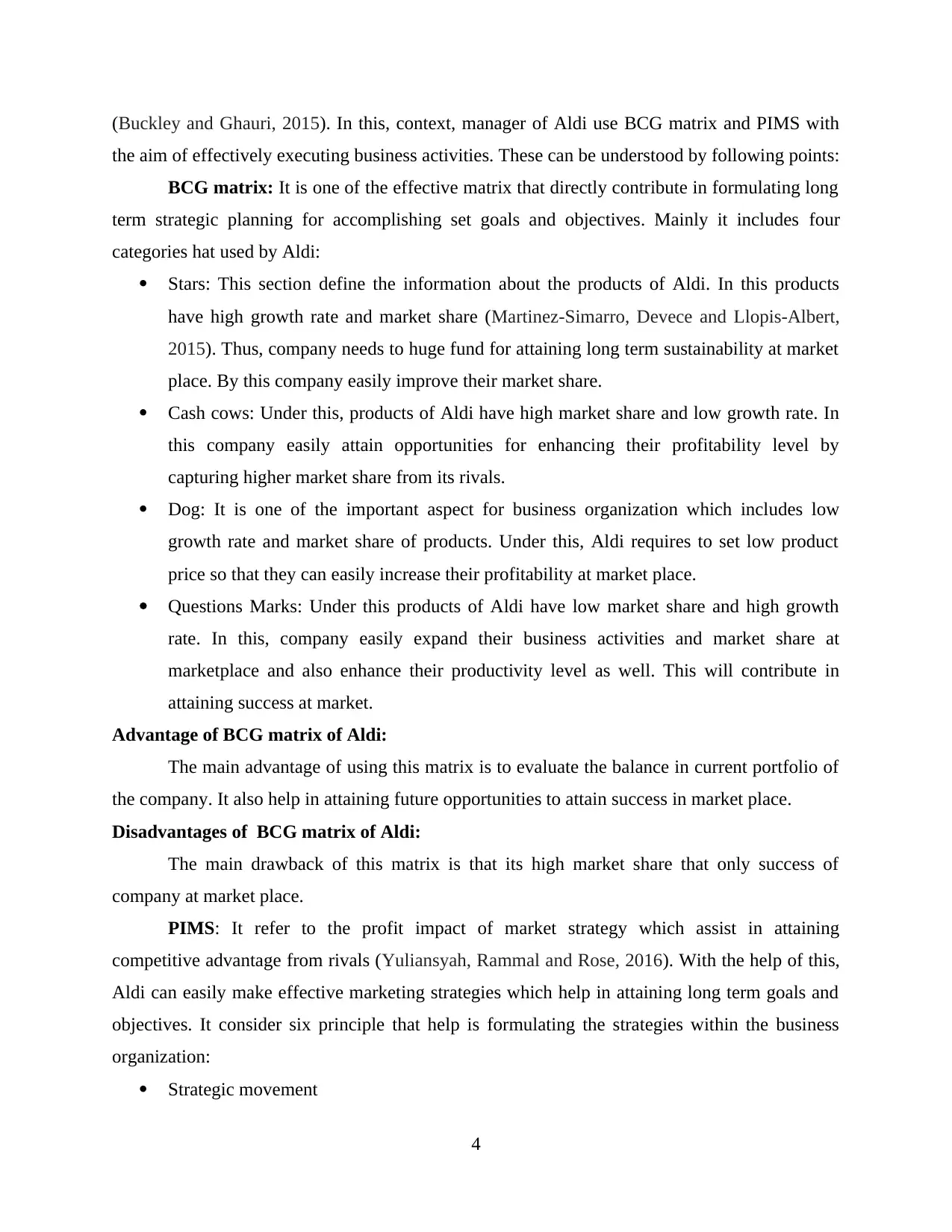
(Buckley and Ghauri, 2015). In this, context, manager of Aldi use BCG matrix and PIMS with
the aim of effectively executing business activities. These can be understood by following points:
BCG matrix: It is one of the effective matrix that directly contribute in formulating long
term strategic planning for accomplishing set goals and objectives. Mainly it includes four
categories hat used by Aldi:
Stars: This section define the information about the products of Aldi. In this products
have high growth rate and market share (Martinez-Simarro, Devece and Llopis-Albert,
2015). Thus, company needs to huge fund for attaining long term sustainability at market
place. By this company easily improve their market share.
Cash cows: Under this, products of Aldi have high market share and low growth rate. In
this company easily attain opportunities for enhancing their profitability level by
capturing higher market share from its rivals.
Dog: It is one of the important aspect for business organization which includes low
growth rate and market share of products. Under this, Aldi requires to set low product
price so that they can easily increase their profitability at market place.
Questions Marks: Under this products of Aldi have low market share and high growth
rate. In this, company easily expand their business activities and market share at
marketplace and also enhance their productivity level as well. This will contribute in
attaining success at market.
Advantage of BCG matrix of Aldi:
The main advantage of using this matrix is to evaluate the balance in current portfolio of
the company. It also help in attaining future opportunities to attain success in market place.
Disadvantages of BCG matrix of Aldi:
The main drawback of this matrix is that its high market share that only success of
company at market place.
PIMS: It refer to the profit impact of market strategy which assist in attaining
competitive advantage from rivals (Yuliansyah, Rammal and Rose, 2016). With the help of this,
Aldi can easily make effective marketing strategies which help in attaining long term goals and
objectives. It consider six principle that help is formulating the strategies within the business
organization:
Strategic movement
4
the aim of effectively executing business activities. These can be understood by following points:
BCG matrix: It is one of the effective matrix that directly contribute in formulating long
term strategic planning for accomplishing set goals and objectives. Mainly it includes four
categories hat used by Aldi:
Stars: This section define the information about the products of Aldi. In this products
have high growth rate and market share (Martinez-Simarro, Devece and Llopis-Albert,
2015). Thus, company needs to huge fund for attaining long term sustainability at market
place. By this company easily improve their market share.
Cash cows: Under this, products of Aldi have high market share and low growth rate. In
this company easily attain opportunities for enhancing their profitability level by
capturing higher market share from its rivals.
Dog: It is one of the important aspect for business organization which includes low
growth rate and market share of products. Under this, Aldi requires to set low product
price so that they can easily increase their profitability at market place.
Questions Marks: Under this products of Aldi have low market share and high growth
rate. In this, company easily expand their business activities and market share at
marketplace and also enhance their productivity level as well. This will contribute in
attaining success at market.
Advantage of BCG matrix of Aldi:
The main advantage of using this matrix is to evaluate the balance in current portfolio of
the company. It also help in attaining future opportunities to attain success in market place.
Disadvantages of BCG matrix of Aldi:
The main drawback of this matrix is that its high market share that only success of
company at market place.
PIMS: It refer to the profit impact of market strategy which assist in attaining
competitive advantage from rivals (Yuliansyah, Rammal and Rose, 2016). With the help of this,
Aldi can easily make effective marketing strategies which help in attaining long term goals and
objectives. It consider six principle that help is formulating the strategies within the business
organization:
Strategic movement
4
Paraphrase This Document
Need a fresh take? Get an instant paraphrase of this document with our AI Paraphraser

Allocation of budget
Production process structure
Competitive position
Result operating
Business environment characteristics
All these are important areas for the business organization to enhance market share of the
company. Along with this, by using this, Aldi can easily retain in market for longer period of
time.
d) Organizational audit for Aldi
Organizational audit is related with the strength and weakness of the company. With the
help of this, company can easily evaluate their current position at market place (Grant, 2016).
For this, company use SWOT analysis to determine their strength, weakness, threat and
opportunities. It also contribute in enhancing their market share at market place.
Strengths:
Positive brand image is major strength of the company.
Aldi serve quality products at affordable cost. Loyal customer base is also a major strength for Aldi.
Weaknesses:
Low margin is major weakness of the company which reduce profitability level. Poor employee satisfaction is also a weakness for Aldi.
Opportunities:
Company expand their operational activities in another countries. Aldi requires more fund for marketing tools so that they can easily enhance their
productivity level.
Threats:
Number of competitors is consider major threat for Aldi.
Change in Government rules and regulation is also a threat.
e) environmental audit for Aldi
Environmental audit is basically an management tool that is used by the organisations
to measure the effects of certain activities on the environment against set criteria or standards. It
5
Production process structure
Competitive position
Result operating
Business environment characteristics
All these are important areas for the business organization to enhance market share of the
company. Along with this, by using this, Aldi can easily retain in market for longer period of
time.
d) Organizational audit for Aldi
Organizational audit is related with the strength and weakness of the company. With the
help of this, company can easily evaluate their current position at market place (Grant, 2016).
For this, company use SWOT analysis to determine their strength, weakness, threat and
opportunities. It also contribute in enhancing their market share at market place.
Strengths:
Positive brand image is major strength of the company.
Aldi serve quality products at affordable cost. Loyal customer base is also a major strength for Aldi.
Weaknesses:
Low margin is major weakness of the company which reduce profitability level. Poor employee satisfaction is also a weakness for Aldi.
Opportunities:
Company expand their operational activities in another countries. Aldi requires more fund for marketing tools so that they can easily enhance their
productivity level.
Threats:
Number of competitors is consider major threat for Aldi.
Change in Government rules and regulation is also a threat.
e) environmental audit for Aldi
Environmental audit is basically an management tool that is used by the organisations
to measure the effects of certain activities on the environment against set criteria or standards. It
5
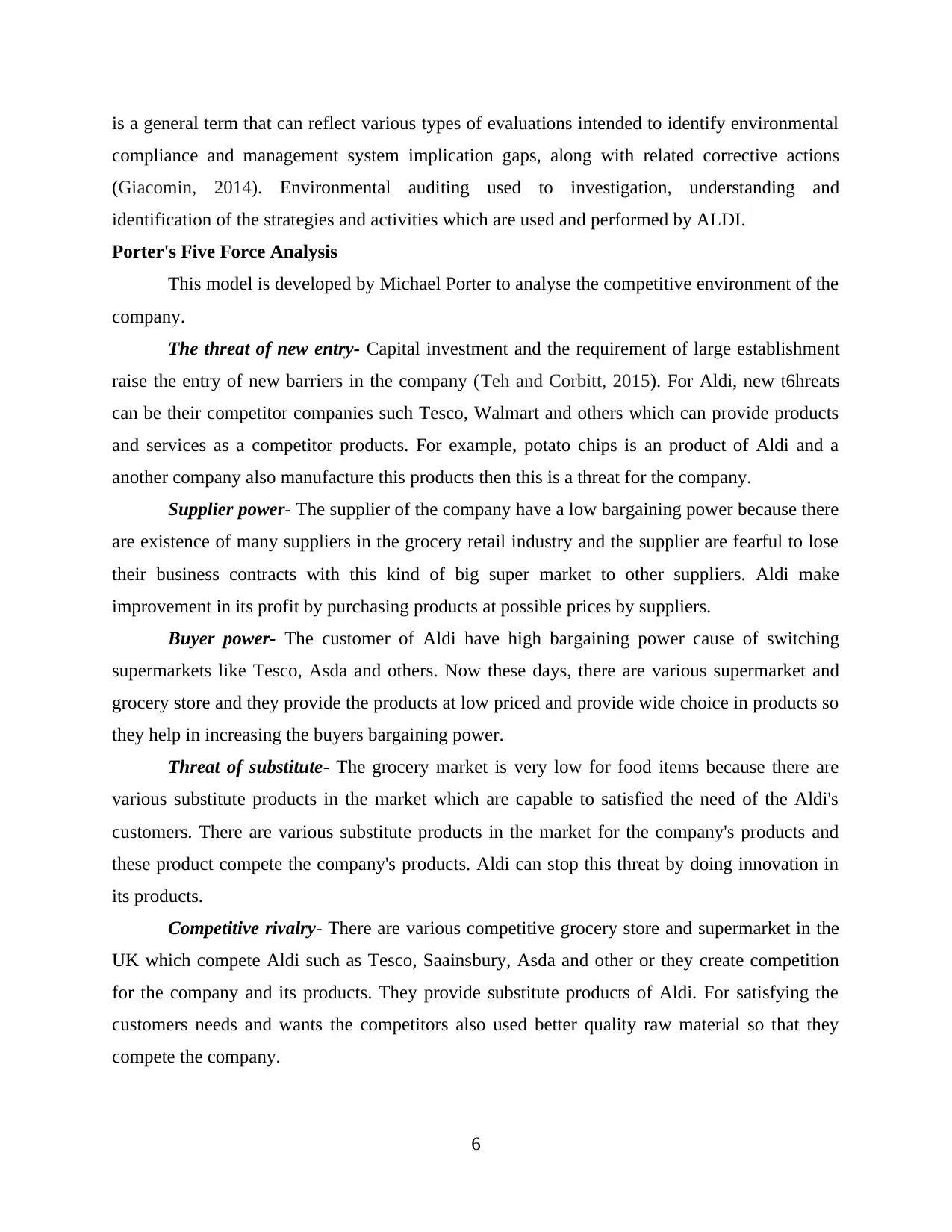
is a general term that can reflect various types of evaluations intended to identify environmental
compliance and management system implication gaps, along with related corrective actions
(Giacomin, 2014). Environmental auditing used to investigation, understanding and
identification of the strategies and activities which are used and performed by ALDI.
Porter's Five Force Analysis
This model is developed by Michael Porter to analyse the competitive environment of the
company.
The threat of new entry- Capital investment and the requirement of large establishment
raise the entry of new barriers in the company (Teh and Corbitt, 2015). For Aldi, new t6hreats
can be their competitor companies such Tesco, Walmart and others which can provide products
and services as a competitor products. For example, potato chips is an product of Aldi and a
another company also manufacture this products then this is a threat for the company.
Supplier power- The supplier of the company have a low bargaining power because there
are existence of many suppliers in the grocery retail industry and the supplier are fearful to lose
their business contracts with this kind of big super market to other suppliers. Aldi make
improvement in its profit by purchasing products at possible prices by suppliers.
Buyer power- The customer of Aldi have high bargaining power cause of switching
supermarkets like Tesco, Asda and others. Now these days, there are various supermarket and
grocery store and they provide the products at low priced and provide wide choice in products so
they help in increasing the buyers bargaining power.
Threat of substitute- The grocery market is very low for food items because there are
various substitute products in the market which are capable to satisfied the need of the Aldi's
customers. There are various substitute products in the market for the company's products and
these product compete the company's products. Aldi can stop this threat by doing innovation in
its products.
Competitive rivalry- There are various competitive grocery store and supermarket in the
UK which compete Aldi such as Tesco, Saainsbury, Asda and other or they create competition
for the company and its products. They provide substitute products of Aldi. For satisfying the
customers needs and wants the competitors also used better quality raw material so that they
compete the company.
6
compliance and management system implication gaps, along with related corrective actions
(Giacomin, 2014). Environmental auditing used to investigation, understanding and
identification of the strategies and activities which are used and performed by ALDI.
Porter's Five Force Analysis
This model is developed by Michael Porter to analyse the competitive environment of the
company.
The threat of new entry- Capital investment and the requirement of large establishment
raise the entry of new barriers in the company (Teh and Corbitt, 2015). For Aldi, new t6hreats
can be their competitor companies such Tesco, Walmart and others which can provide products
and services as a competitor products. For example, potato chips is an product of Aldi and a
another company also manufacture this products then this is a threat for the company.
Supplier power- The supplier of the company have a low bargaining power because there
are existence of many suppliers in the grocery retail industry and the supplier are fearful to lose
their business contracts with this kind of big super market to other suppliers. Aldi make
improvement in its profit by purchasing products at possible prices by suppliers.
Buyer power- The customer of Aldi have high bargaining power cause of switching
supermarkets like Tesco, Asda and others. Now these days, there are various supermarket and
grocery store and they provide the products at low priced and provide wide choice in products so
they help in increasing the buyers bargaining power.
Threat of substitute- The grocery market is very low for food items because there are
various substitute products in the market which are capable to satisfied the need of the Aldi's
customers. There are various substitute products in the market for the company's products and
these product compete the company's products. Aldi can stop this threat by doing innovation in
its products.
Competitive rivalry- There are various competitive grocery store and supermarket in the
UK which compete Aldi such as Tesco, Saainsbury, Asda and other or they create competition
for the company and its products. They provide substitute products of Aldi. For satisfying the
customers needs and wants the competitors also used better quality raw material so that they
compete the company.
6
⊘ This is a preview!⊘
Do you want full access?
Subscribe today to unlock all pages.

Trusted by 1+ million students worldwide
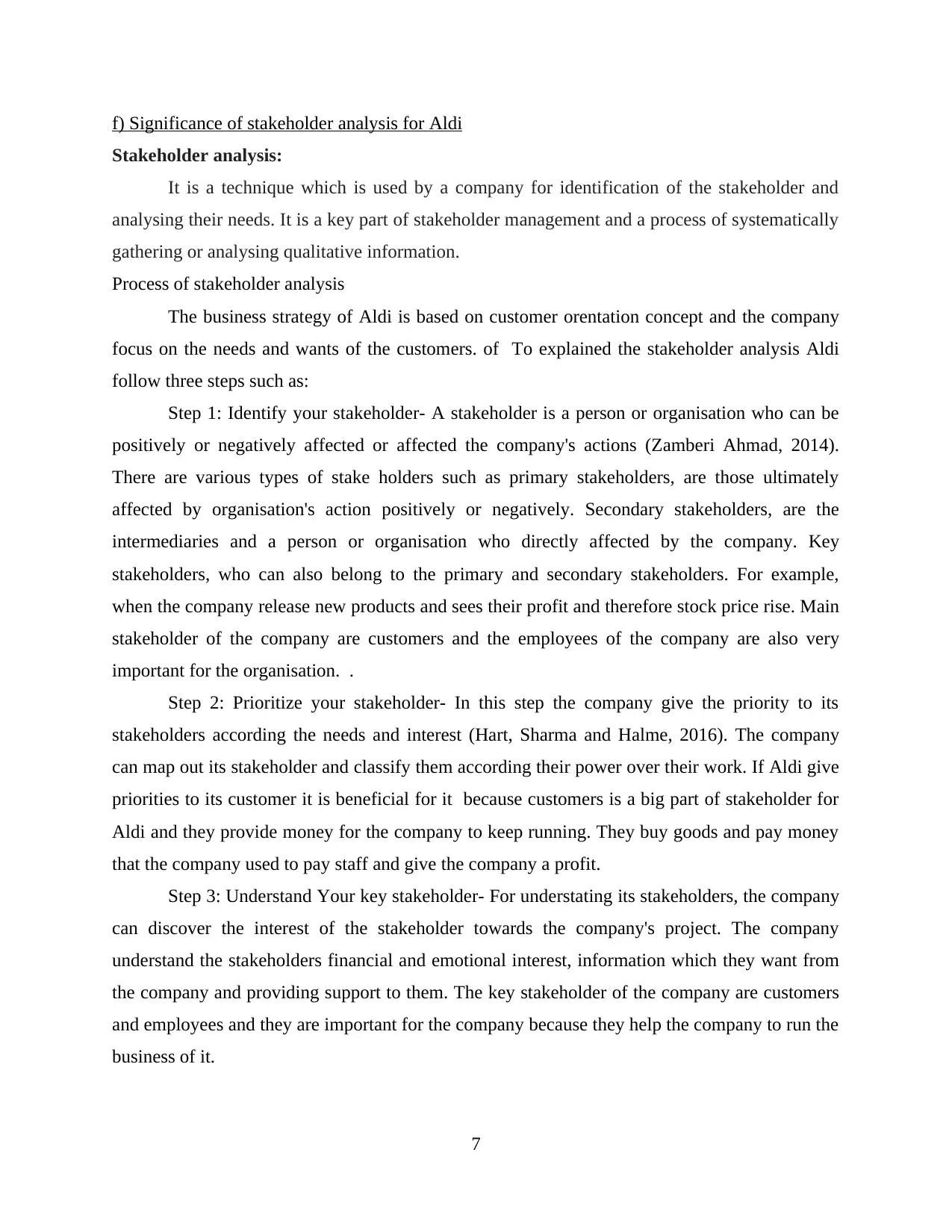
f) Significance of stakeholder analysis for Aldi
Stakeholder analysis:
It is a technique which is used by a company for identification of the stakeholder and
analysing their needs. It is a key part of stakeholder management and a process of systematically
gathering or analysing qualitative information.
Process of stakeholder analysis
The business strategy of Aldi is based on customer orentation concept and the company
focus on the needs and wants of the customers. of To explained the stakeholder analysis Aldi
follow three steps such as:
Step 1: Identify your stakeholder- A stakeholder is a person or organisation who can be
positively or negatively affected or affected the company's actions (Zamberi Ahmad, 2014).
There are various types of stake holders such as primary stakeholders, are those ultimately
affected by organisation's action positively or negatively. Secondary stakeholders, are the
intermediaries and a person or organisation who directly affected by the company. Key
stakeholders, who can also belong to the primary and secondary stakeholders. For example,
when the company release new products and sees their profit and therefore stock price rise. Main
stakeholder of the company are customers and the employees of the company are also very
important for the organisation. .
Step 2: Prioritize your stakeholder- In this step the company give the priority to its
stakeholders according the needs and interest (Hart, Sharma and Halme, 2016). The company
can map out its stakeholder and classify them according their power over their work. If Aldi give
priorities to its customer it is beneficial for it because customers is a big part of stakeholder for
Aldi and they provide money for the company to keep running. They buy goods and pay money
that the company used to pay staff and give the company a profit.
Step 3: Understand Your key stakeholder- For understating its stakeholders, the company
can discover the interest of the stakeholder towards the company's project. The company
understand the stakeholders financial and emotional interest, information which they want from
the company and providing support to them. The key stakeholder of the company are customers
and employees and they are important for the company because they help the company to run the
business of it.
7
Stakeholder analysis:
It is a technique which is used by a company for identification of the stakeholder and
analysing their needs. It is a key part of stakeholder management and a process of systematically
gathering or analysing qualitative information.
Process of stakeholder analysis
The business strategy of Aldi is based on customer orentation concept and the company
focus on the needs and wants of the customers. of To explained the stakeholder analysis Aldi
follow three steps such as:
Step 1: Identify your stakeholder- A stakeholder is a person or organisation who can be
positively or negatively affected or affected the company's actions (Zamberi Ahmad, 2014).
There are various types of stake holders such as primary stakeholders, are those ultimately
affected by organisation's action positively or negatively. Secondary stakeholders, are the
intermediaries and a person or organisation who directly affected by the company. Key
stakeholders, who can also belong to the primary and secondary stakeholders. For example,
when the company release new products and sees their profit and therefore stock price rise. Main
stakeholder of the company are customers and the employees of the company are also very
important for the organisation. .
Step 2: Prioritize your stakeholder- In this step the company give the priority to its
stakeholders according the needs and interest (Hart, Sharma and Halme, 2016). The company
can map out its stakeholder and classify them according their power over their work. If Aldi give
priorities to its customer it is beneficial for it because customers is a big part of stakeholder for
Aldi and they provide money for the company to keep running. They buy goods and pay money
that the company used to pay staff and give the company a profit.
Step 3: Understand Your key stakeholder- For understating its stakeholders, the company
can discover the interest of the stakeholder towards the company's project. The company
understand the stakeholders financial and emotional interest, information which they want from
the company and providing support to them. The key stakeholder of the company are customers
and employees and they are important for the company because they help the company to run the
business of it.
7
Paraphrase This Document
Need a fresh take? Get an instant paraphrase of this document with our AI Paraphraser

g) New strategy for Aldi
Providing an organisation with a common purpose, goals and set of actions to reach the
goal ensures that everyone in the company working for the same outcome and that time and
resources are allocated to the same goals and objectives. Every new strategy is important for
ALDI, in decision making, more focused, more productive and more profitable. Aldi launch a
new product and for that new product it can adopt this strategy.
Porter's generic strategies
This strategy can be used by ALDI to determine the direction of the company. There are
four strategies which are given by Porter. They are following:
Cost Leadership- In this strategy the company increasing profit by reducing costs. ALDI
is a hard discounted store pursuing cost leadership strategy (Lueg, 2015). This company buys
low price land mostly on city outskirts, builds cheap warehouse and it does not provide free
shopping bag and encourage its customers to bring their own bags or purchase new shopping
bag. If the company use low price strategy, it can retain its customers and satisfied them with
affordable pricing strategy. ALDI maintained its position as the UK's fastest growing grocer
amid by its better cost leadership.
Differentiation- By using this strategy ALDI, the customers of the company, get good
quality product and the employees get good salary package. It make changes in its products and
prices by using pricing and other strategies according the customers demands and needs which
differentiate it from other company (Hernández-Perlines, Moreno-García and Yañez-Araque,
2016). By making and doing differentiation in its pricing strategies and product differentiation
the company create efficiency, clarity and clear orientation for its customers.
Cost focus- In it a company focus on cost advantages in its target segments. The
company target a niche market and offer the lowest possible price. By focusing on its pricing
strategies it achieve its future goals.
Differentiation focus- The company target a niche market where there are little
competition and product and services has unique features. It is very important for the company
that the product remains unique that stay in competition. Focusing on the customers needs and
demands or making strategies for them, the company provide products according their needs and
achieve its future objectives.
8
Providing an organisation with a common purpose, goals and set of actions to reach the
goal ensures that everyone in the company working for the same outcome and that time and
resources are allocated to the same goals and objectives. Every new strategy is important for
ALDI, in decision making, more focused, more productive and more profitable. Aldi launch a
new product and for that new product it can adopt this strategy.
Porter's generic strategies
This strategy can be used by ALDI to determine the direction of the company. There are
four strategies which are given by Porter. They are following:
Cost Leadership- In this strategy the company increasing profit by reducing costs. ALDI
is a hard discounted store pursuing cost leadership strategy (Lueg, 2015). This company buys
low price land mostly on city outskirts, builds cheap warehouse and it does not provide free
shopping bag and encourage its customers to bring their own bags or purchase new shopping
bag. If the company use low price strategy, it can retain its customers and satisfied them with
affordable pricing strategy. ALDI maintained its position as the UK's fastest growing grocer
amid by its better cost leadership.
Differentiation- By using this strategy ALDI, the customers of the company, get good
quality product and the employees get good salary package. It make changes in its products and
prices by using pricing and other strategies according the customers demands and needs which
differentiate it from other company (Hernández-Perlines, Moreno-García and Yañez-Araque,
2016). By making and doing differentiation in its pricing strategies and product differentiation
the company create efficiency, clarity and clear orientation for its customers.
Cost focus- In it a company focus on cost advantages in its target segments. The
company target a niche market and offer the lowest possible price. By focusing on its pricing
strategies it achieve its future goals.
Differentiation focus- The company target a niche market where there are little
competition and product and services has unique features. It is very important for the company
that the product remains unique that stay in competition. Focusing on the customers needs and
demands or making strategies for them, the company provide products according their needs and
achieve its future objectives.
8

By using cost leadership it can provide its products at a better pricing without any loss in
its business. By using approach the company can offer a limited number of good quality products
at a low price.It can provide product at affordable price and the customer are loyal for it. By this
it can create netter relationship with its existing customers and others.
PART 2
a) Identify market and appropriateness of strategy
It is important for every business organization determine the market and strategies with
the purpose of enhancing their market share. With the assistance of this, company can easily
capture larger market share from its rivals. In context of this, Aldi is famous multinational
organization provide best quality products to its customers for attaining their higher satisfaction
level. For attaining success at market place, Aldi expand their business in Asia with the aim of
enhancing their market share. By this they can easily established their positive brand image and
at the time also tries to increase profitability level by serving quality products. For this, Aldi use
substantive growth strategy through which firm tries to capture larger market share in Asia.
Mainly, this type of strategy help business organization two ways. In first way, company
collaborate with clients in same area to increase market share profitability as well (Schaltegger,
Hansen and Lüdeke-Freund, 2016). On the other side, implement new technology which help
them in expanding their operational activities in another countries. Both are more effective that
provide future opportunities to the Aldi sustain in market for longer period of time. For attaining
the same, company needs to make their products more unique and popular in front of customers.
This will help in enhancing the brand image at market place and at the same time also create
strong customers base.
b) Justification of the strategies for market entry
For attaining success at market place, it is important for business organization to use
effective strategy through which they can easily capture larger market share from its rivals. As
Aldi adopt Substantive growth strategy with the aim of expanding their business in Asia market.
In this company needs to serve quality products and services to its target customers according to
their needs and wants (Karami, Sahebalzamani and Sarabi, 2015). By this company can easily
established their competitive position at market place. In this, Aldi offer their products by using
online software in which they easily reach target customers. It also help Aldi to enhance their
9
its business. By using approach the company can offer a limited number of good quality products
at a low price.It can provide product at affordable price and the customer are loyal for it. By this
it can create netter relationship with its existing customers and others.
PART 2
a) Identify market and appropriateness of strategy
It is important for every business organization determine the market and strategies with
the purpose of enhancing their market share. With the assistance of this, company can easily
capture larger market share from its rivals. In context of this, Aldi is famous multinational
organization provide best quality products to its customers for attaining their higher satisfaction
level. For attaining success at market place, Aldi expand their business in Asia with the aim of
enhancing their market share. By this they can easily established their positive brand image and
at the time also tries to increase profitability level by serving quality products. For this, Aldi use
substantive growth strategy through which firm tries to capture larger market share in Asia.
Mainly, this type of strategy help business organization two ways. In first way, company
collaborate with clients in same area to increase market share profitability as well (Schaltegger,
Hansen and Lüdeke-Freund, 2016). On the other side, implement new technology which help
them in expanding their operational activities in another countries. Both are more effective that
provide future opportunities to the Aldi sustain in market for longer period of time. For attaining
the same, company needs to make their products more unique and popular in front of customers.
This will help in enhancing the brand image at market place and at the same time also create
strong customers base.
b) Justification of the strategies for market entry
For attaining success at market place, it is important for business organization to use
effective strategy through which they can easily capture larger market share from its rivals. As
Aldi adopt Substantive growth strategy with the aim of expanding their business in Asia market.
In this company needs to serve quality products and services to its target customers according to
their needs and wants (Karami, Sahebalzamani and Sarabi, 2015). By this company can easily
established their competitive position at market place. In this, Aldi offer their products by using
online software in which they easily reach target customers. It also help Aldi to enhance their
9
⊘ This is a preview!⊘
Do you want full access?
Subscribe today to unlock all pages.

Trusted by 1+ million students worldwide
1 out of 18
Related Documents
Your All-in-One AI-Powered Toolkit for Academic Success.
+13062052269
info@desklib.com
Available 24*7 on WhatsApp / Email
![[object Object]](/_next/static/media/star-bottom.7253800d.svg)
Unlock your academic potential
Copyright © 2020–2025 A2Z Services. All Rights Reserved. Developed and managed by ZUCOL.





